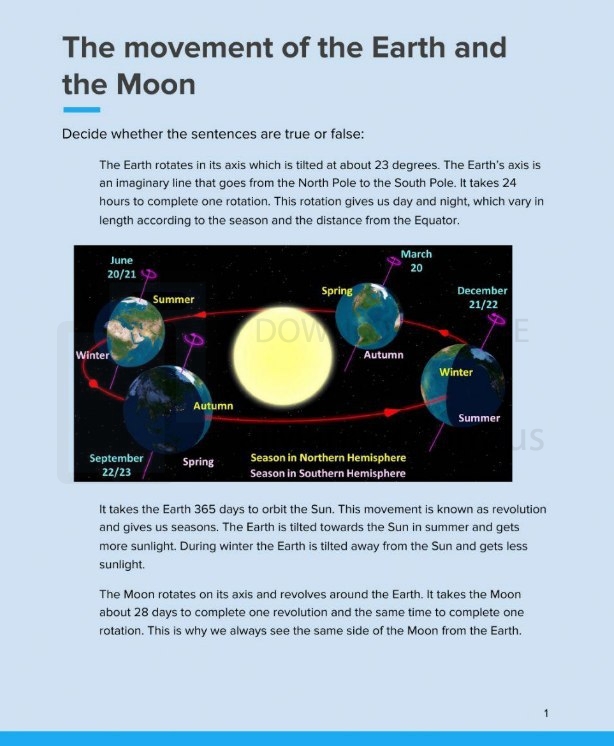| You are here: Almanahj Website ⇒ American curriculum ⇒ 11th Grade ⇒ Geology ⇒ Term 1 | ||
|---|---|---|
Worksheet about The Movement of the Earth and the Moon | ||
|---|---|---|
| Subject: Geology | ||
| 11th Grade | ||
| Term 1 | ||
| Year: 2023/2024 | ||
| Size: 271.6KB | ||
| Number of clicks: 164 | ||
| Publish date:November 27, 2023 | ||
| Added by: Eman | ||
| Last download date: 2024-09-11 04:22:51 | By: theodor JessicaMc | |
| File info: The Earth and the Moon have several significant movements that contribute to their dynamic relationship. Here are the key movements of the Earth and the Moon: Earth's Rotation: As mentioned earlier, the Earth rotates on its axis, causing the cycle of day and night. The rotation of the Earth is counterclockwise when viewed from above the North Pole. It takes approximately 24 hours for the Earth to complete one rotation. Moon's Revolution: The Moon revolves around the Earth in an elliptical orbit. This motion is known as the Moon's revolution. It takes about 27.3 days for the Moon to complete one orbit around the Earth. This period is called the sidereal month. Earth's Revolution: Just like the Moon, the Earth also revolves around the Sun in an elliptical orbit. This motion is known as the Earth's revolution. It takes approximately 365.25 days (or one year) for the Earth to complete one orbit around the Sun. This period is called the tropical year. Synchronous Rotation: An interesting aspect of the Earth-Moon system is that the Moon is tidally locked to the Earth, meaning that the same side of the Moon always faces the Earth. This is a result of the gravitational interactions between the two bodies. As a result, the Moon also undergoes a rotation on its axis that takes the same amount of time as its orbital period around the Earth. This is why we always see the same side of the Moon from Earth. Lunar Phases: The Moon's revolution around the Earth causes different phases of the Moon to be visible from Earth. As the Moon orbits the Earth, the angle between the Sun, Earth, and Moon changes, leading to different portions of the Moon's illuminated surface being visible. These phases include new moon, crescent moon, first quarter moon, gibbous moon, and full moon. Lunar Eclipse: Occasionally, the Earth, Moon, and Sun align in such a way that the Earth casts a shadow on the Moon, resulting in a lunar eclipse. This occurs when the Moon passes through the Earth's shadow, causing it to temporarily darken or appear reddish. Solar Eclipse: Similarly, a solar eclipse occurs when the Moon passes between the Earth and the Sun, blocking the Sun's light and casting a shadow on the Earth. This can result in a partial or total solar eclipse, depending on the alignment. These movements of the Earth and the Moon have significant effects on various phenomena, such as the length of a day, the cycle of lunar phases, and the occurrence of eclipses. They also influence tides on Earth, as the gravitational pull of the Moon and the Sun causes the oceans to rise and fall in a regular pattern. | ||
| Downloading link Worksheet about The Movement of the Earth and the Moon |
|---|
|
1701082738.pdf
The file is being prepared for download
|
| File images |
|---|
 |